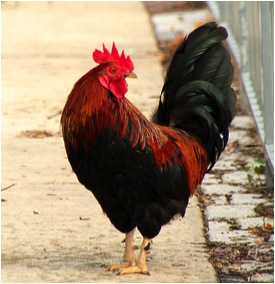Table of Contents
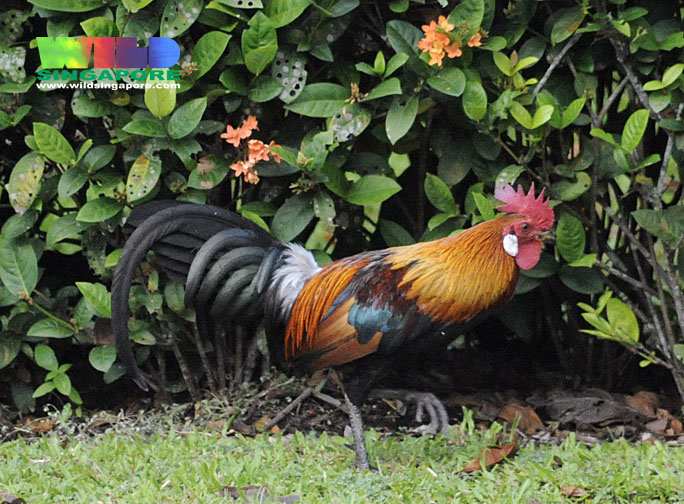 |
| Photo by: Ria Tan |
Binomial name: Gallus gallus (Linnaeus, 1758)
Common name: Red Jungle Fowl
First named Phasianus gallus by Linnaeus in 1758 in 10th edition of Systema Naturae. This was later revised as Gallus gallus by Brisson in 1760.
Taxonavigation
Knowing how the Red Jungle Fowl is classified helps in further understanding of the animal since general traits can be deciphered based on classification. Also, knowing these traits and classification opens doors to other resources for information since the appropriate search terms can be used.
Class: Aves
Order: Galliformes
Family: Phasianidae
Genus: Gallus
Family has 38 genera and 155 species (del Hoyo et al., 1994)
Members of this family share characteristics like leg spurs which are bony cores on legs (Brooke & Birkhead, 1991, del Hoyo et al., 1994). Morphologically, other similarities include having squat bodies which are “large in relation to the head, bill and short neck” (del Hoyo et al., 1994).
Genus Gallus
There are three other species of jungle fowls in the Genus Gallus.
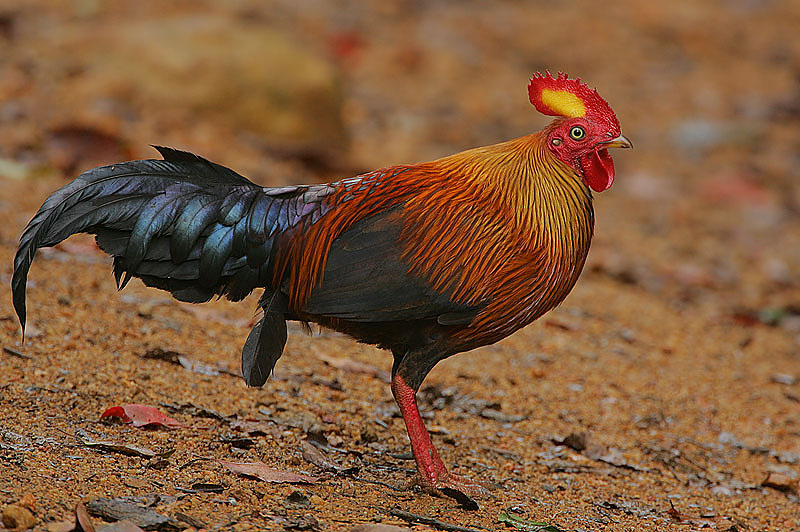 |
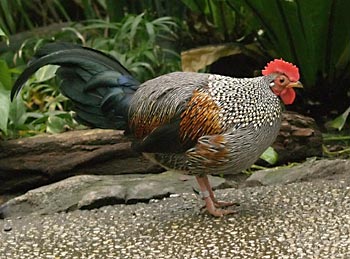 |
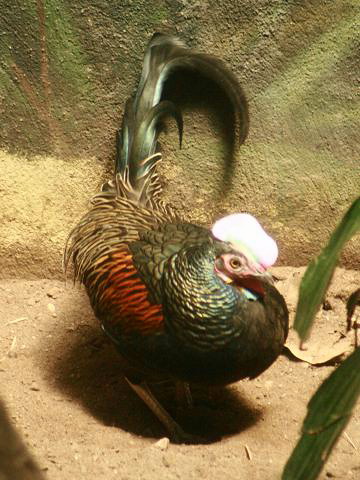 |
| Gallus lafayetti (Ceylon Jungle Fowl) |
Gallus sonneratti (Grey Jungle Fowl) |
Gallus varius (Green Jungle Fowl) |
These species are spatially separated. The Red Jungle Fowl is native in the region of Southeast Asia (Wang and Hails, 2007; Long, 1981; IUCN Red List) while the Ceylon, Grey and Green Jungle Fowl are native in Sri Lanka, Peninsula India and Java respectively (del Hoyo et al., 1994).
Subspecies of Gallus gallus has also been described. Khin (1992) distinguished the subspecies according to the shape of the neck feathers and the colour of the earlobes in the male.
Subspecies of Gallus gallus (Red Jungle Fowl)
- Gallus gallus gallus (Indochina Red Jungle Fowl)
- Gallus gallus bankiva (Java Red Jungle Fowl)
- Gallus gallus jabouillei (Tokinese Red Jungle Fowl)
- Gallus gallus spadiceus (Cochin-Chinese Red Jungle Fowl)
- Gallus gallus murghi (Indian Red Jungle Fowl)
- Gallus gallus domesticus (Domestic chicken)
Diagnosis
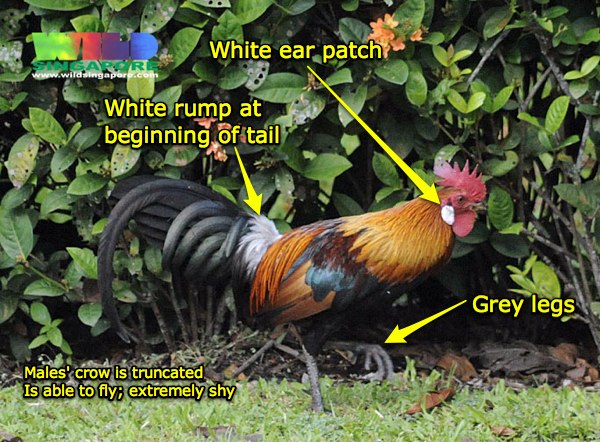 |
| Male Red Jungle Fowl with diagnostic characteristics. Photo by: Ria Tan, Annotations by: N. Sivasothi and Amanda Tan |
The Red Jungle Fowl is known to be the wild ancestor of the domestic chicken (Gallus gallus domesticus) and hence bears many resemblances to the domestic chicken. However, the birds can be differentiatied both morphological and biological means.
| Types of features |
Feature |
Red Jungle Fowl |
Domestic chicken |
||||
|
|
||||||
| Morphological |
White ear patch |
Present |
Absent |
||||
| Colour of legs |
Grey |
Yellow |
|||||
| Biological |
Ability to fly |
Yes |
No |
||||
| Call |
*Abrupt ending of the last note (About 0.4s) |
*Dragging of the last note (1.3s) |
|||||
| Temperament |
Shy |
Bold |
Description
Linneaus (1758) did not distinguish between the Red Jungle Fowl and domestic chicken. Original description cannot be deciphered due to the language barrier but some attributes can be found in the more recent literature.
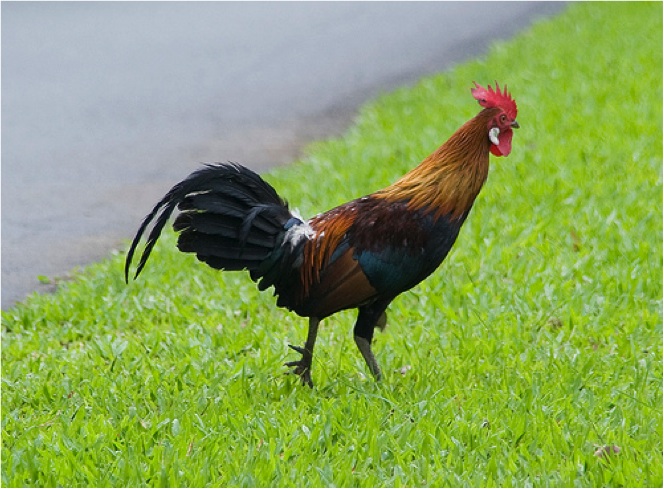 |
| Male Red Jungle Fowl. Photo by: Ria Tan |
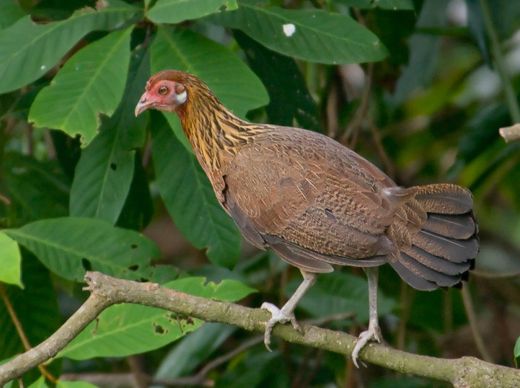 |
| Female Red Jungle Fowl. Photo by: Allan Teo |
Head:
White ear patch present; apparent on the male, less apparent on the female (Davison & Chew, 1995)
Size:
40 to 75 cm (Fisher & Peterson, 1964)
Feet:
Grey
Plumage:
The Red Jungle Fowl displays sexual dimorphism- the male and female appearance differ. The most prominent difference between the sexes is the plumage which can easily be used to tell them apart. This difference in plumage is deemed to play an “important role in courtship” (Fisher & Peterson, 1964)
Male: Ornamental; Colourful, usually green, red and brown
Female: Dark brown with yellow streaks on the neck (Davison & Chew, 1995)
Vocal repertoire:
Male: Crow most distinctive
Females: Cackle. Females cackle post-oviposition to incite male competition (Fisher & Peterson, 1964; Birkhead et al., 1996). This insemination window is optimal for fertilisation of the next egg to be laid.
Biology
Feeding habits:
The Red Jungle Fowl is omnivorous and consumes a variety of items like grain, weed seeds, berries and other plant matter as well as numerous species insects and invertebrates (del Hoyo et al., 1994).
A study conducted in north-central India in the Siwalik Hills found that the Red Jungle Fowl are common where there are termite mounds and small fruiting trees like Chamro trees (Ehretia laevis). The Red Jungle Fowl was “often seen perching in the branches and eating its small red fruits”. Other food sources include Banyan trees (Ficus bengalensis) and dung inhabiting insects (Collias & Collias, 1967). However, it was noted that the diet of the Red Jungle Fowl differs according to seasons (Collias & Collias, 1967).
In Singapore, the Red Jungle Fowl has been documented to eat a range of food including invertebrates like earthworms or centipedes.
Reproduction:
This species is known to breed in spring and summer but is known to differ depending on the location (Collias & Collias, 1967). The gestation period of the eggs of the Red Jungle Fowls is 21 days. In captivity, the lifespan of the Red Jungle Fowl averages 15-20 years though it has been known to live up to 30 years (Encyclopedia of Life, 2011).
Brooding behaviour:
Dominant male fowl is commonly found with up to 20 females in a flock (Johnson, 1963; Davison et al., 2008).
Distribution
The Red Jungle Fowl is native in Southwest Yunnan, Myanmar, Thailand, Malay Peninsula, Singapore, North Sumatra, north-western Himalayas and northern India (Wang & Hails, 2007; Long, 1981; IUCN Red List), but is known to have been introduced to Australia, Marshall Islands, Micronesia, Federated States of Nauru, Northern Mariana Islands, Palau and United States (IUCN Red List, 2011).
Domestication of the Red Jungle Fowl
The Red Jungle Fowl continental population of Gallus gallus has been found to be the origin of domestic chicken populations (Fumihito et al., 1996). The domestication event dates back to the earliest known cities of India, Mohenjo-daro and Harappa, which flourished between 3300 and 2500 BCE, had clay figurines bearing resemblance to fowls as captive birds. Bones found in Mohenjo-daro showed that the birds were bred for size (Brooke & Birkhead, 1991). West and Zhou (1988) suggested that the domestication happened in Southeast Asia before 6000 BCE. The selection for increased egg production is also obvious since the average number of eggs laid per year in 1940 was 120 compared to 260 40 years later. It is said that domesticated chickens now lay more than 365 eggs a year, compared to dozens in the Red Jungle Fowl (Brooke & Birkhead, 1991).
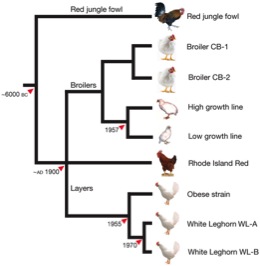 |
| Sequencing chicken lines shows Red Jungle Fowl as the ancestor. Picture from: Rubin et al., 2010 |
Threats to the Red Jungle Fowl
The Red Jungle Fowls are the wild ancestors of the domestic chickens and are able to interbreed to form hybrids. Internationally, the biggest threat to the Red Jungle Fowl is genetic hybridization since wild Red Jungle Fowls commonly mate with free-ranging domestic chickens. Peterson and Brisbin (1999) compared 745 genetic samples of the Red Jungle Fowl and found that most wild populations have genetically contaminated genes by the introgressions of genes from domestic chickens. Morejohn (1968) attributed the loss of eclipse plumage, yellow legs of the domestic chicken and presence of hen comb to the dilution of genes.
The hybrid offspring is known to lack the distinct combination of features which characterise the Red Jungle Fowl (Davison & Chew, 1995). In this video of a hybrid, the bird did not have a white ear patch nor a white rump.
On Pulau Ubin, however, this threat was reduced with the ban of keeping live poultry on Pulau Ubin in June 2005 (AVA). With fewer domestic chickens on the island, the risk of the wild Red Jungle Fowl interbreeding with domestic chickens has decreased.
Other threats to this bird include illegal trade, poaching and loss of habitat (Lim, 1992). Jungle Fowls are largely ground dwellers and are vulnerable to traps (Davison et al., 2008) while removal of forest for development results in the loss of habitat (Lim, 1992).
Status of Red Jungle Fowls in Singapore
Though the IUCN Red List status of the Red Jungle Fowl worldwide is Least Concern (LC), the Red Jungle Fowl is considered an uncommon resident in Singapore. The national status of the Red Jungle Fowl in Singapore is endangered and is considered to be “facing a very high risk of extinction in the wild in Singapore” (Davison et al., 2008).
A survey done by Bucknill & Chasen (1927) showed that there were no Red Jungle Fowls in Singapore. This species was said to be locally extinct (Lim, 2009b). During the period 1985-1986, local bird-watcher Lim Kim Keung began finding the Red Jungle Fowl on Pulau Ubin. Interviews with Ubin residents reveal that this bird was only seen on the island in 1980s (Lim, 2009b) and subsequently mainland in 1993 (Wang & Hails, 2007). It has been speculated that the bird migrated from Johor, Malaysia to colonise Pulau Ubin first and subsequently mainland Singapore (Lim, 2009). This speculation could be confirmed using genetic methods but has not been done to date.
The birds have been seen on the east side of mainland Singapore at places like Pasir Ris Park since 1998 (Lim & Lim, 2009) and in the west at Western Catchment since the 2000s (Wang & Hails, 2007). Further inland, the birds have been seen at Bukit Batok Nature Park and Bukit Batok West (Lim, 2008, 2009a, 2010). Local birdwatchers reported sightings of this bird on the Bird Ecology Study Group blog. However, while a maximum of 18 were counted on Pulau Ubin in July 2009, Red Jungle Fowls further inland Singapore are often only spotted individually or in pairs throughout 2008 to January 2010.
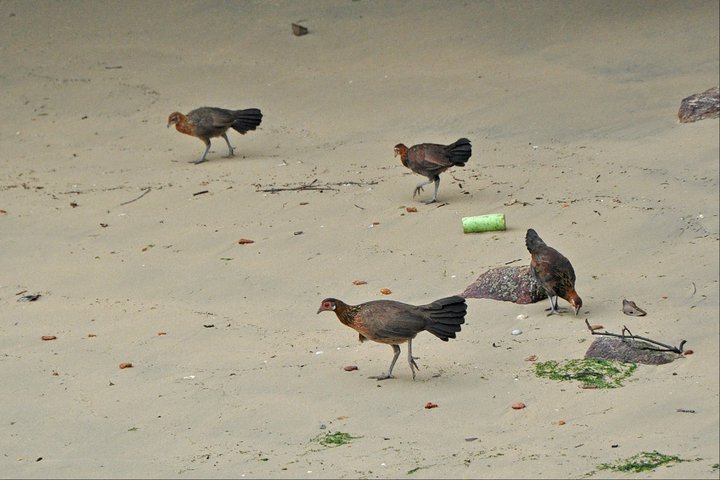 |
| Female Red Jungle Fowls seen foraging at Chek Jawa, Pulau Ubin at low tide. Photo by: Rene Ong |
*Status of Red Jungle Fowls in Singapore accurate as of 7 November 2011.
Distribution of Red Jungle Fowls in Singapore
Records submitted by the public between September and October 2010 was collated together with mainland Singapore records from birdwatchers and mapped onto Google Maps. The records were mapped only if pictures taken were seen to fit the morphology of the Red Jungle Fowl or are from members of the naturalist community. The map showed that the distribution of the bird on mainland Singapore was scattered.
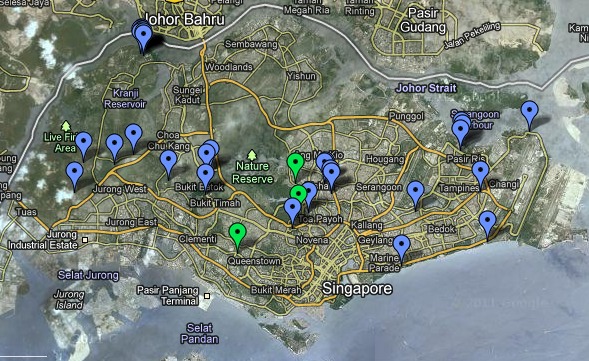 |
| Map of Red Jungle Fowl distribution on mainland Singapore. Blue pins show sightings with Red Jungle Fowl morphology. Green pins are populations with hybrid morphology. Collated by: Amanda Tan |
Future studies
The potential for genetic hybridization in the Red Jungle Fowl can be a cause for concern, especially if there are free-ranging domestic chickens or hybrids. Genetic studies can be carried out to determine the origins of the Red Jungle Fowls in Singapore, to see if the birds colonized Singapore from Malaysia and to confirm the genetic purity of the bird.
Further records of the bird can be collated. Occasional records are submitted to Habitatnews. These records can be continually monitored to map the spreading distribution of the bird and the habitat it uses. It was observed that the bird could make use of secondary forests, indicating that secondary forests represent a significant habitat availability. It is thus important for constant monitoring of the biodiversity at these areas.
References
Agri-Food & Veterinary Authority of Singapore: Wild Animals and Birds Act. URL: http://www.ava.gov.sg/NR/rdonlyres/0CA18578-7610-4917-BB67-C7DF4B96504B/13804/Attach73_legislation_WildAnimalsandBirdsAct.pdf. Accessed 29 October 2011.
Birkhead, T. R., E. J. A., Cunningham & K. M., Cheng, 1996. The Insemination Window Provides a Distorted View of Sperm Competition in Birds. Proceedings: Biological Sciences, 263 (1374): 1187-1192.
Brisson,1760. Ornithologia sive synopsis methodice sistens Avium divisiones in ordine,1:26,166.
Brooke, M. & T., Birkhead, 1991. The Cambridge Encyclopedia of Ornithology. Cambridge University Press, Cambridge. 362pp.
Bucknill, J. A. S. & F. N., Chasen, 1927. Birds of Singapore and South-east Asia. 1990 reprint. Graham Brash, Singapore. 247pp.
Collias, N. E. & E. C., Collias, 1967. A Field Study of the Red Jungle Fowl in North-Central India. Cooper Ornithological Society, 69 (4): 360-386.
Davison, G. W. H & Y. F., Chew, 1995. A Photographic Guide to Birds in Peninsular Malaysia and Singapore. New Holland (Publishers), London. 144pp.
Davison G. W. H., P. K. L., Ng & H. C., Ho, 2008. The Singapore Red Data Book: Threatened Plants and Birds of Singapore. Second Edition. The Nature Society (Singapore), Singapore. 285pp.
Del Hoyo, J., A., Elliott & D. A., Christie., 1994. Handbook of the Birds of the World, New World Vultures to Guineafowl: Volume 2. Lynx Edicions, Barcelona: 638pp.
Encyclopedia of Life. URL: http://eol.org/pages/1049263/overview. Accessed on 29 October 2011.
Fisher, J. & R. T. Peterson, 1964, The World of Birds: A Comprehensive Guide to General Ornithology. MacDonald and Co, London 288p.
Fumihito, A., Miyake, T., M., Takada, R., Shingu, T., Endoll, T., Gojobori, N., Kondo & S., Ohno., 1996. Monophylectic origin and unique dispersal patterns of domestic fowls. Proceedings of the National Academy of Sciences, 93: 6792-6795.
IUCN Red List- Gallus gallus. URL: http://www.iucnredlist.org/apps/redlist/details/141319/0. Accessed on 29 October 2011.
Johnson, R. A., 1963. Habitat Preference and Behavior of Breeding Jungle Fowl in Central Western Thailand. Wilson Ornithological Society, 75 (3): 270-272.
Lim, K. C., 2008. Bird Report: Singapore. Singapore Avifauna, 22 (9): 4.
Lim, K. C., 2009a. Bird Report: Singapore. Singapore Avifauna, 23 (6): 3.
Lim, K. C., 2010. Bird Report: Singapore. Singapore Avifauna, 24 (1): 17.
Lim, K. C. & K. S., Lim, 2009. State of Singapore’s Wild Birds and Bird Habitats: A Review of the Annual Bird Census 1996-2005. Nature Society (Singapore), Singapore. 402pp.
Lim, K. S., 1992. Vanishing Birds of Singapore. The Nature Society (Singapore), Singapore. 103pp.
Lim, K.S., 2009b. The Avifauna of Singapore. Nature Society (Singapore), Singapore. 611pp.
Linnaeus, C. 1758. Tomus I. Systema naturae per regna tria naturae, secundum classes, ordines, genera, species, cum characteribus, differentiis, synonymis, locis. Editio decima, reformata. Holmiae. (Laurentii Salvii).: [1-4], 1-824.
Long, J. L., 1981. Introduced Birds of the World. Universe Books, New York. 528pp.
Morejohn, G. V., 1968. Study of plumage of four species of the genus Gallus. The Condor, 70 (1): 56-65.
Peterson, A. T. and I. L., Brisbin, 1999. Genetic endangerment of wild Red Junglfowl Gallus gallus. Bird Conservation International, 9: 387-394.
Rubin, C.-J., M. C., Zody, J., Eriksson, J. R. S., Meadows, E., Sherwood, M. T., Webster, L., Jiang, M. Ingman, T., Sharpe, S., Ka, F., Hallbook, F. , Besnier, O., Carlborg, B., Bed'hom, M., Tixier-Boichard, P., Jensen, P., Siegel, K., Lindblad-Toh & L., Andersson, 2010. Whole genome resequencing reveals loci under selection during chicken domestication. Nature, 464: 587-591
Wang, L.K. & C. J., Hails, 2007. An Annotated Checklist of Birds of Singapore. Raffles Bulletin of Zoology Supplement No. 15, 179pp.
West, B. & B.-X., Zhou, 1988. Did chickens go north? New evidence for domestication. Journal of Archaeological Science, 15: 515-533.
